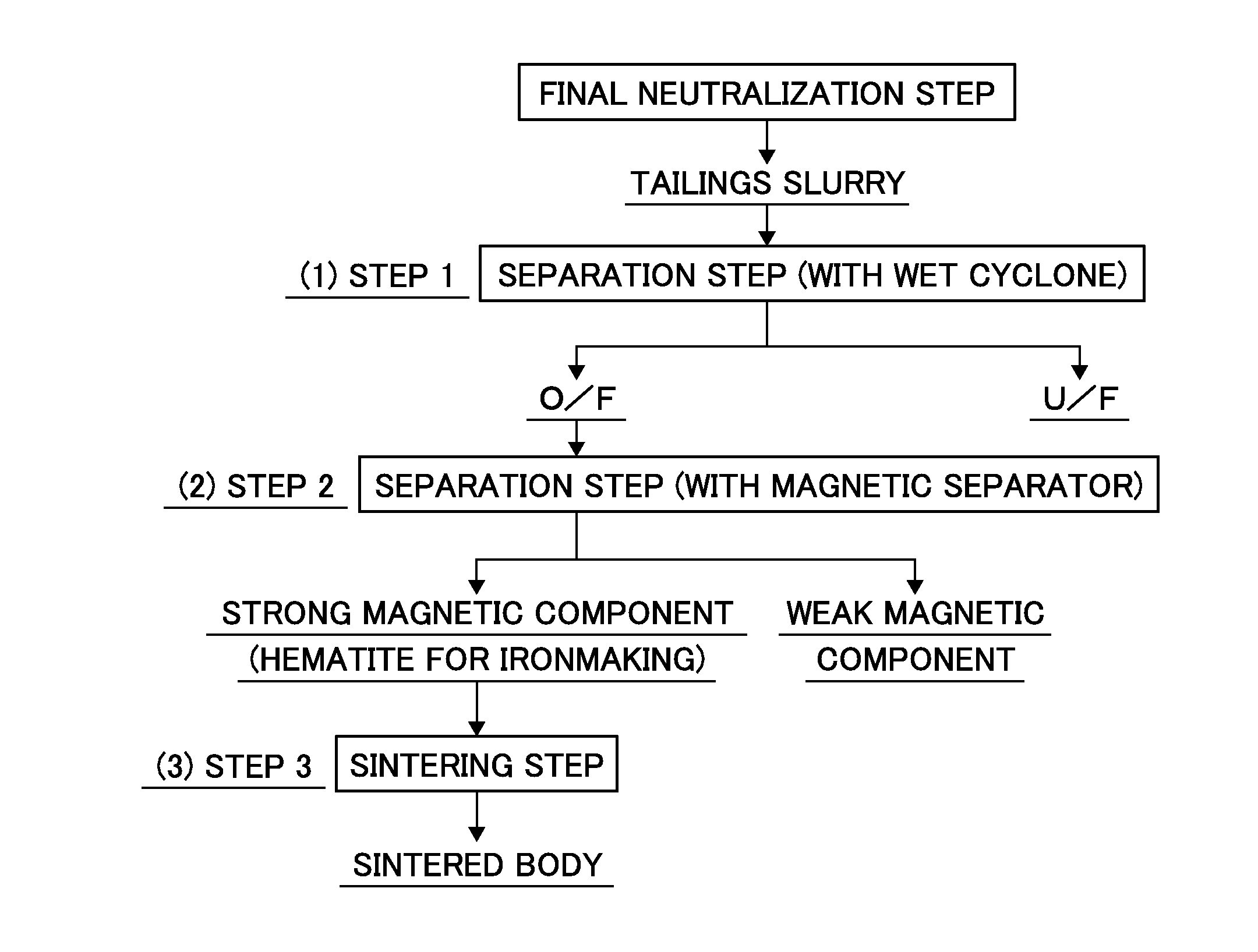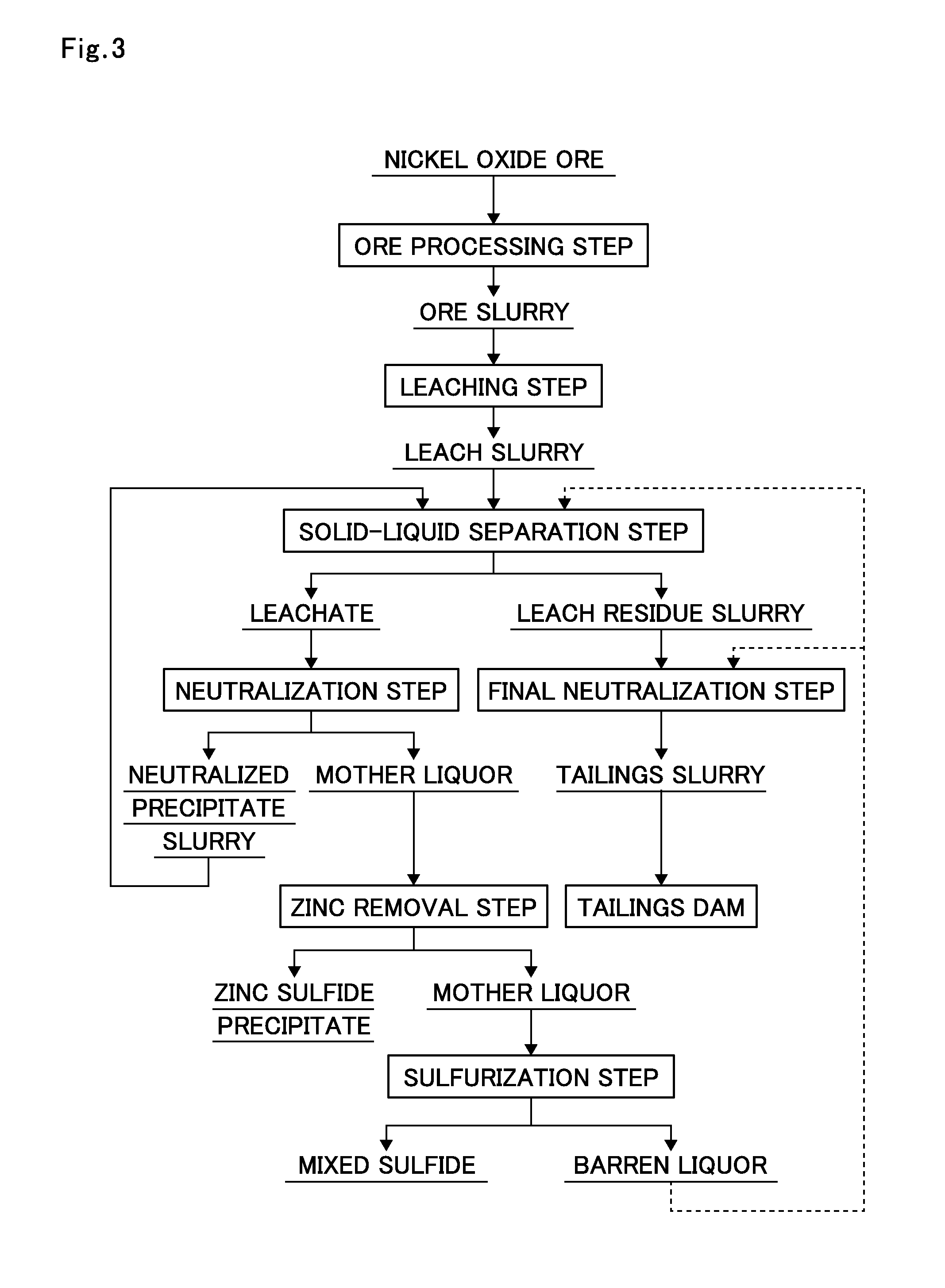Process for producing hemataite for ironmaking
- Summary
- Abstract
- Description
- Claims
- Application Information
AI Technical Summary
Benefits of technology
Problems solved by technology
Method used
Image
Examples
example 1
[0072]The present invention was applied in the separation of the tailings slurry described in Table 1. The tailings slurry was first treated with a wet cyclone in which the setting of the classification size for the overflow was 1.2 μm or less as the classification condition shown in Table 1, and then the resulting overflow was separated with the above magnetic separator.
[0073]With respect to the treatment amount of solids, 10 tons of the tailings slurry was treated, and the weight of the resulting overflow in a slurry state was 9.1 tons.
[0074]As a result of magnetic separation, a hematite cake having an iron grade of 53%, a sulfur (S) grade of 0.7%, and a solid weight of 2.2 tons was obtained. The particle size of the hematite was 0.6 μm.
[0075]The hematite cake (10 cm×20 cm×1 cm) was sintered at 1150° C. for 10 minutes. The resulting hematite sintered body had a density of 4.0 g / cm3, an iron grade of 54%, and a sulfur (S) grade of 0.08%.
example 2
[0076]The present invention was applied in the separation of the tailings slurry described in Table 1. The tailings slurry was first treated with a wet cyclone in which the setting of the classification size for the overflow was 1.2 μm or less as the classification condition shown in Table 1, and then the resulting overflow was separated with the magnetic separator.
[0077]With respect to the treatment amount of solids, 10 tons of the tailings slurry was treated, and the weight of the resulting overflow in a slurry state was 9.1 tons.
[0078]2.2 tons of the hematite cake obtained by the magnetic separation was subjected to high pressure filter pressing (with a high pressure heating filter) to thereby obtain a hematite cake having an iron grade of 52%, a sulfur (S) grade of 0.8%, a moisture content of 15%, and a solid weight of 2.0 tons. The particle size of the resulting hematite was 0.7 μm.
[0079]The hematite cake (10 cm×20 cm×1 cm) was heated at 1350° C. for 10 minutes. The resulting h...
example 3
[0080]The present invention was applied in the separation of the tailings slurry described in Table 1. The tailings slurry was first treated with a wet cyclone in which the setting of the classification size for the overflow was 1.2 μm or less as the classification condition shown in Table 1, and then the resulting overflow was separated with the above magnetic separator. With respect to the treatment amount of solids, 10 tons of the tailings slurry was treated. The weight of the resulting overflow in a slurry state was 9.1 tons.
[0081]2.2 tons of the hematite cake obtained by the magnetic separation was subjected to high pressure filter pressing (with a high pressure heating filter) to thereby obtain 2.0 tons a hematite cake having an iron grade of 52%, a sulfur (S) grade of 0.8%, and a moisture content of 15%. The particle size of the resulting hematite was 0.7 μm.
[0082]The resulting hematite cake (10 cm×20 cm×1 cm) was sintered at 1150° C. for 10 minutes.
[0083]The resulting sinter...
PUM
| Property | Measurement | Unit |
|---|---|---|
| Temperature | aaaaa | aaaaa |
| Length | aaaaa | aaaaa |
| Length | aaaaa | aaaaa |
Abstract
Description
Claims
Application Information
 Login to View More
Login to View More - R&D
- Intellectual Property
- Life Sciences
- Materials
- Tech Scout
- Unparalleled Data Quality
- Higher Quality Content
- 60% Fewer Hallucinations
Browse by: Latest US Patents, China's latest patents, Technical Efficacy Thesaurus, Application Domain, Technology Topic, Popular Technical Reports.
© 2025 PatSnap. All rights reserved.Legal|Privacy policy|Modern Slavery Act Transparency Statement|Sitemap|About US| Contact US: help@patsnap.com



